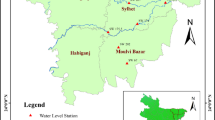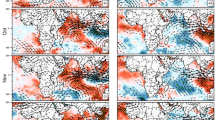Abstract
Forecasting, with precision, the location of landfall and the height of surge of cyclonic storms prevailing over any ocean basin is very important to cope with the associated disasters. The main objective of the present research is to develop models to forecast the exact location of landfall and the surge heights of tropical cyclones over North Indian Ocean. Artificial neural network (ANN) model is developed for forecasting the location (latitude–longitude) of landfall, and neuro-fuzzy coupled (NFC) model is developed for forecasting the surge heights. The sea surface temperature, vertical wind, minimum pressure at the centre of the cyclones, maximum wind speed and pressure drop at the centre are taken to form the input matrix of both the models. The result shows that position of landfall can be predicted with high accuracy with ANN model. The result further reveals that the prediction error with NFC model in forecasting the surge height is 2.448 % with 6-h lead time, whereas the error is observed to increase with the increase in lead time. However, for forecasting the surge height with 18-h lead time, the accuracy is observed to be 11.4 %. The skill of both the models is verified through validation with the observations of cyclones Jal (2010) and Thane (2011).










Similar content being viewed by others
References
Aberson SD (2001) The ensemble of tropical cyclone track forecasting models in the North Atlantic basin (1976–1998). Bull Am Meteorol Soc 2:1895–1904
Ali A (1979) Storm surge in Bay of Bengal and some related problems. Ph.D. thesis. University of Reading, England, 227 pp
Bo F, Liu JNK (2005) An adaptive neural network classifier for tropical cyclone prediction using a two-layer feature selector. Adv Neural Netw 3497:399–404
Bose NK, Liang P (1995) Neural Network Fundamentals with Graphs, algorithms and applications, McGraw Hill, international edition. MIT Press, Cambridge
Chaudhuri S (2010) Convective energies in forecasting severe thunderstorms with one hidden layer neural net and variable learning rate back propagation algorithm. Asia-Pacific J Atmos Sci 46(2):173–183
Chaudhuri S, Middey A (2011) Adaptive neuro fuzzy inference system to forecast gust speed during thunderstorm. Meteorol Atmos Phys 114:139–149
Chaudhuri S, Middey A, Goswami S, Banerjee S (2012a) Appraisal of the prevalence of severe tropical storms over Indian Ocean by screening the features of tropical depressions. Nat Hazards 61(2):745–756
Chaudhuri S, Dutta D, Goswami S, Middey A (2012) Intensity forecast of tropical cyclones over North Indian Ocean using multi layer perceptron model: skill and performance verification. Nat Hazards. doi:10.1007/s11069-012-0346-7
Chaudhuri S, Goswami S, Middey A (2013) Medium-range forecast of cyclogenesis over North Indian Ocean with multilayer perceptron model using satellite data. Nat Hazards. doi:10.1007/s11069-013-0805-9
Chittibabu P (1999) Development of storm surge prediction models for the Bay of Bengal and the Arabian Sea. Ph.D. thesis, IIT Delhi, India, 262 pp
Chittibabu P, Dube SK, Rao AD, Sinha PC, Murty TS (2000) Numerical simulation of extreme sea levels using location specific high resolution model for Gujarat coast of India. Mar Geod 23:133–142
Chittibabu P, Dube SK, Rao AD, Sinha PC, Murty TS (2002) Numerical simulation of extreme sea levels for the Tamilnadu (India) and Sri Lanka coasts. Mar Geod 25:235–244
Das PK (1972) A prediction model for storm surges in the Bay of Bengal. Nature 239:211–213
Das PK (1994a) Prediction of storm surges in the Bay of Bengal. Proc Indian Natl Sci Acad 60:513–533
Das PK (1994b) On the prediction of storm surges. Sadhana 19:583–595. doi:10.1007/BF02835641
Das PK, Sihna MC, Balasuburamanyam V (1974) Storm surges in Bay of Bengal. Q J R Meteorol Soc 100(425):437–449
Davies C, Wang W, Chen S, Chen Y, Corbosiero K, DeMaria M, Dudhia J, Holland G, Klemp J, Michalakes J, Reeves H, Rotunno R, Snyder C, Xiao Q (2007) Prediction of land falling hurricanes with advanced hurricane WRP Model. Mon Weather Rev 136:1990–2005
Dube SK, Sinha PC, Rao AD, Rao GS (1985) Numerical modeling of storm surges in the Arabian Sea. Appl Math Model 9:289–294
Dube SK, Sinha PC, Rao AD, Chittibabu P (1994) A real time storm surge prediction system: an application to east coast of India. Proc Indian Natl Sci Acad 60:157–170
Dube SK, Rao AD, Sinha PC, Murty TS, Bahuhayan N (1997) Storm surge in the Bay of Bengal and Arabian Sea: the problem and its prediction. Mausam 48(2):283–304
Dube SK, Chittibabu P, Rao AD, Sinha PC, Murty TS (2000) Extreme sea levels associated with severe tropical cyclones hitting Orissa coast of India. Mar Geod 23:75–90. doi:10.1080/01490410050030652
Dube SK, Chittibabu P, Sinha PC, Rao AD, Murty TS (2004) Numerical modeling of storm surges in the head Bay of Bengal using location specific model. Nat Hazards 31:437–453
Dube SK, Sinha PC, Rao AD, Jain I, Agnihotri N (2005) Effect of Mahanadi river on the development of storm surge along the Orissa coast of India: a numerical study. Pure appl Geophys 162:1673–1688. doi:10.1007/s00024-005-2688-5
Dube SK, Jain I, Rao AD (2006) Numerical storm surge prediction model for the North Indian Ocean and the South China Sea. Disaster Dev 1:47–63
Duong TH, Nguyen DC, Nguyen SD, Hoang MH (2013) An Adaptive neuro-fuzzy inference system for seasonal forecasting of tropical cyclones making landfall along the Vietnam coast. Adv Comput Methods Knowl Eng Stud Comput Intell 479:225–236
Elsberry RL, Marks FD (1999) The hurricane landfall workshop summary. Bull Am Meteorol Soc 80:683–685
Flowerdew J, Mylne K, Jones C, Titley H (2012) Extending the forecast range of the UK storm surge ensemble. Q J R Meteorol Soc (online first) doi:10.1002/qj.1950
Gardner MW, Dorling SR (1998) Artificial neural networks (the multilayer perceptron)—a review of applications in the atmospheric sciences. Atmos Environ 32:2627–2636
Ghose SK (1977) Prediction of storm surge on the East Coast of India. J Meteorol Hydrol Geophys 28(2):157–168
Gönnert G, Dube SK, Murty T, SiefertW (2001) Global storm surges: theory, observations and applications. Die Kueste. 623
Gupta MC, Sharma VK (2000) Orissa Super Cyclone 99, National Center for Disaster Management, Indian Institute of Public Administration, New Delhi. New United Press
Haykin S (1999) Neural networks, a comprehensive foundation, 2nd edn. Prentice Hall, New Jersey
Houston SH, Powell MD (1993) Surface wind fields during Hurricane Bob’s (1991) landfall in New England. Preprints, 20th conference on hurricanes and tropical meteorology. San Antonio, TX, American Meteorological Society, pp 139–142
Jain I, Chittibabu P, Agnihotri N, Dube SK, Sinha PC, Rao AD (2006a) Simulation of storm surges along Myanmar coast using a location specific numerical model. Nat Hazards 39:71–82
Jain I, Chittibabu P, Agnihotri N, Dube SK, Sinha PC, Rao AD (2006b) Numerical storm surge prediction model for Gujarat coast of India and adjoining Pakistan coast. Nat Hazards 42:67–73
Jang JSR, Sun CT, Mizutani E (1997) Neuro-Fuzzy and soft computing. Prentice-Hall, Englewood Cliffs
Jarvinen BR, Neumann CJ, Davis MAS (1984) A tropical cyclone data tape for the North Atlantic basin, 1886–1983: contents, limitations, and uses. NOAA technical memo. NWS NHC 22, 21
Johns B, Ali A (1980) The numerical modeling of storm surges in the Bay of Bengal. Q J R Meteorol Soc 106:1–8
Johns B, Dube SK, Mohanty UC, Sinha PC (1981) Numerical simulation of the surge generated by the 1977 Andhra Cyclone. Q J R Meteorol Soc 107:915–934
Kalnay E et al (1996) The NCEP/NCAR 40-year reanalysis project. Bull Am Meteorol Soc 77:437–470
Lee TL (2009) Prediction of Typhoon Storm Surge using artificial neural network. Adv Eng Softw 40:1200–1206
Lee RST, Liu JNK (2002) An automatic tropical cyclone pattern recognition and classification system using composite neural oscillatory-based EGDLM. J Fuzzy Syst 4:616–625
Majumdar KK (2003) A mathematical model of the nascent cyclone. IEEE Trans Geosci Remote Sens 41(5):1118–1122
Mamdani EH (1974) Application of fuzzy algorithm for control of simple dynamic planet. Proc Inst Elect Eng 121:1585–1588
McAdie CJ, Lawrence MB (2000) Improvements to tropical cyclone track forecasting in the Atlantic basin, 1970–1998. Bull Amer Meteorol Soc 81:989–999
Murty TS (1984) Storm surges: meteorological ocean tides. Department of Fisheries and Oceans, Ottawa
Murty TS, Henry RF (1983) Tides in the Bay of Bengal. J Geophys Res 88(c-10):6069–6076
Murty TS, Flather RA, Henry RF (1986) The storm surge problem in the Bay of Bengal. Prog Oceanogr 16:195–233. doi:10.1016/0079-6611(86)90039-X
Neumann CJ, Pelissier JM (1981) An analysis of Atlantic tropical cyclone forecast errors, 1970–1979. Mon Weather Rev 109:1248–1266
NWS (1999) Vision 2005. National Weather Service strategic plan for weather, water, and climate services 2000–2005. 24. Available from NWS, 1325 East–West Highway, Silver Spring, MD 20910-3283
Pal SK, Mitra S (1999) Neuro-fuzzy pattern recognition: Methods in soft computing. Wiley, New York
Pedro JS, Burstein F (2003) A framework for case-based fuzzy multicriteria decision support for tropical cyclone forecasting. In: Proceedings of the 36th Hawaii international conference on system sciences (HICSS’03) 0-7695-1874-5/03 $17.00 © 2002 IEEE
Rao AD (1982) Numerical storm surge prediction in India. Ph.D. thesis, IIT Delhi, New Delhi, 211 pp
Rao YR, Chittibabu P, Dube SK, Rao AD, Sinha PC (1997) Storm surge prediction and frequency analysis for Andhra coast of India. Mausam (New Delhi) 48:555–566
Reynolds RW, Rayner NA, Smith TM, Stokes DC, Wang W (2002) An improved in situ and satellite SST analysis for climate. J Climate. 15:1609–1625
Roy GD (1984) Numerical storm surge prediction in Bangladesh. Ph.D. thesis, Indian Institute of Technology, Delhi, 188 pp
Singh SK, Kishtawal CM, Pal PK (2012) Track prediction of Indian Ocean cyclones using Lagrangian advection model. Nat Hazards 62:745–778. doi:10.1007/s11069-012-0121-9
Sugeno M (1985) An introductory survey of fuzzy control. Inf Sci 36(1–2):59–83
Sugeno M, Kang G (1988) Structure identification of fuzzy model. Fuzzy Sets Syst 26(1):15–33
Sugeno M, Tanaka K (1991) Successive identification of a fuzzy model and its application to prediction of a complex system. Fuzzy Sets Syst 42:315–334
Tanagi T, Sugeno M (1985) Fuzzy identification of systems and its application to modelling and control. IEEE Trans Syst Cybern SMC-15.1: 116–132
Zadeh LA (1965) Fuzzy sets. Inf Control 8(3):353–383
Acknowledgments
The authors acknowledge the India Meteorological Department for providing the data for research. The authors gratefully acknowledge the Editor-in-Chief and the anonymous reviewers for constructive review and supportive comments which helped to improve the clarity of the paper.
Author information
Authors and Affiliations
Corresponding author
Rights and permissions
About this article
Cite this article
Chaudhuri, S., Goswami, S., Middey, A. et al. Predictability of landfall location and surge height of tropical cyclones over North Indian Ocean (NIO). Nat Hazards 75, 1369–1388 (2015). https://doi.org/10.1007/s11069-014-1376-0
Received:
Accepted:
Published:
Issue Date:
DOI: https://doi.org/10.1007/s11069-014-1376-0




